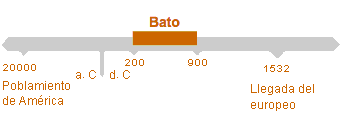The Bato people inhabited the coastal regions, inland valleys, and Andean highlands of Central Chile, but were most concentrated in the lands between the Petorca and Maipo rivers. The climate in this period was more or less the same as it is today—Mediterranean with rain in the winter and long, dry summers. Scrubland (matorral) was the main form of vegetation, with some woodland along water courses in the Coastal Mountains and the Andes, and grassy meadows on the banks of mountain streams.
How to Arrive
El Museo se encuentra ubicado en pleno centro de Santiago, en la esquina de las calles Bandera y Compañía, a una cuadra de la Plaza de Armas.
Tickets
Chileans and resident foreigners: $1,000 Foreigners: $8,000 Chilean students and resident foreigners: $500 Foreign students: $4,000
Guided Visit
El Museo cuenta con un servicio de guías, sin costo adicional, para los establecimientos educacionales.
Information for Teachers
Invitamos especialmente a coordinarse con alguno de nuestros guías para programar una visita o actividades de motivación y seguimiento que aprovechen de la mejor forma la experiencia de visitarnos.
Audioguides
Download recordings of the Permanent Exhibition display texts in English, French, Portuguese and Spanish here. These audioguides are in mp3 format and are arranged by cultural area, following the same order as our exhibit galleries. Descargue desde esta página audioguías en castellano, inglés, francés y portugués con los textos de las vitrinas de la […]






































